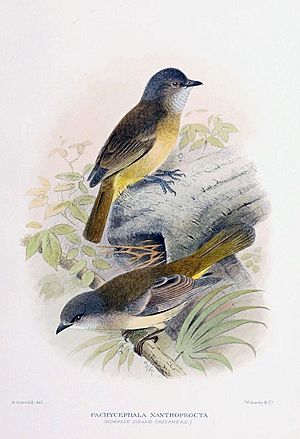Norfolk golden whistler facts for kids
Quick facts for kids Norfolk golden whistler |
|
|---|---|
 |
|
| Conservation status | |
| Scientific classification |
|
| Kingdom: | Animalia |
| Phylum: | Chordata |
| Class: | Aves |
| Order: | Passeriformes |
| Family: | Pachycephalidae |
| Genus: | Pachycephala |
| Species: | |
| Subspecies: |
P. p. xanthoprocta
|
| Trinomial name | |
| Pachycephala pectoralis xanthoprocta Gould, 1838
|
|
| Synonyms | |
|
|
The Norfolk golden whistler (Pachycephala pectoralis xanthoprocta) is a small, special bird. People on Norfolk Island sometimes call it the "tamey." It belongs to the whistler family. This bird is a type of Australian golden whistler. You can only find it on Norfolk Island, which is an Australian territory. Norfolk Island is located in the Tasman Sea, between Australia and New Zealand.
Contents
Description
What Does It Look Like?
Male Norfolk golden whistlers look a bit different from other golden whistlers. They don't have the super bright yellow, white, and black colors. Instead, they look more like the female birds. However, the males are usually a bit yellower than the females.
Compared to most other types of golden whistlers, the Norfolk golden whistler is smaller. It also has a longer tail and a stronger, heavier beak.
Distribution and Habitat
Where Does It Live?
The Norfolk golden whistler lives only on Norfolk Island. Most of these birds are found in the Norfolk Island National Park. Specifically, they live in the Mt Pitt section of the park. You can also find them in small wooded areas up to 2 kilometers (about 1.2 miles) from the park.
What Kind of Home Does It Like?
These birds prefer to live in certain types of forests. They like the bushy plants found under the main trees in subtropical rainforests. They also live in palm forests and areas with Norfolk Island pine trees. Sometimes, they visit gardens too. They can even be found in forests that are growing back after being cleared.
Status and Conservation
Why Is It Special?
The Norfolk golden whistler is considered a vulnerable species. This means it needs help to survive. It is vulnerable because there aren't many of them. Also, they only live in a small area on Norfolk Island.
How Many Are There?
In the 1960s and 1970s, the number of these birds went down. But by 2005, scientists estimated there were about 535 breeding pairs. A breeding pair means a male and female bird that can have babies.
What Are the Dangers?
The Norfolk golden whistler faces several threats.
- Habitat loss: Their homes are being damaged. This happens when plants they need are removed or replaced by other plants.
- Predators: Black rats and feral cats hunt and eat the birds. These animals were brought to the island by people.
How Are People Helping?
People are working to protect the Norfolk golden whistler.
- Controlling pests: They are trying to control the number of rats and feral cats. This helps to keep the birds safe from being hunted.
- Controlling weeds: They are also removing invasive weeds. These weeds can take over the birds' natural habitat.
- New homes: There are plans to move some whistlers to nearby Phillip Island. This will happen when the forest there grows back enough to be a good home for them.


